Emergency Nursing Case Study: COPD Patient Assessment and Treatment
VerifiedAdded on 2021/04/17
|10
|2451
|84
Case Study
AI Summary
This case study presents an emergency nursing scenario involving a patient diagnosed with Chronic Obstructive Pulmonary Disease (COPD). The patient's initial presentation included severe respiratory distress, abnormal vital signs, and signs of hypoxemia. The assessment encompasses the patient's symptoms, spirometric results, arterial blood gas analysis, and Glasgow Coma Scale (GCS) assessment. The case study further explores the use of Bi-level Positive Airway Pressure (BiPAP) therapy, its physiological effects, benefits, and potential risks. It also discusses the correction of hypoxemia and hypercapnia, outlining the benefits and risks associated with oxygen therapy. The case study highlights the importance of prompt assessment and appropriate interventions in managing COPD exacerbations in an emergency setting.
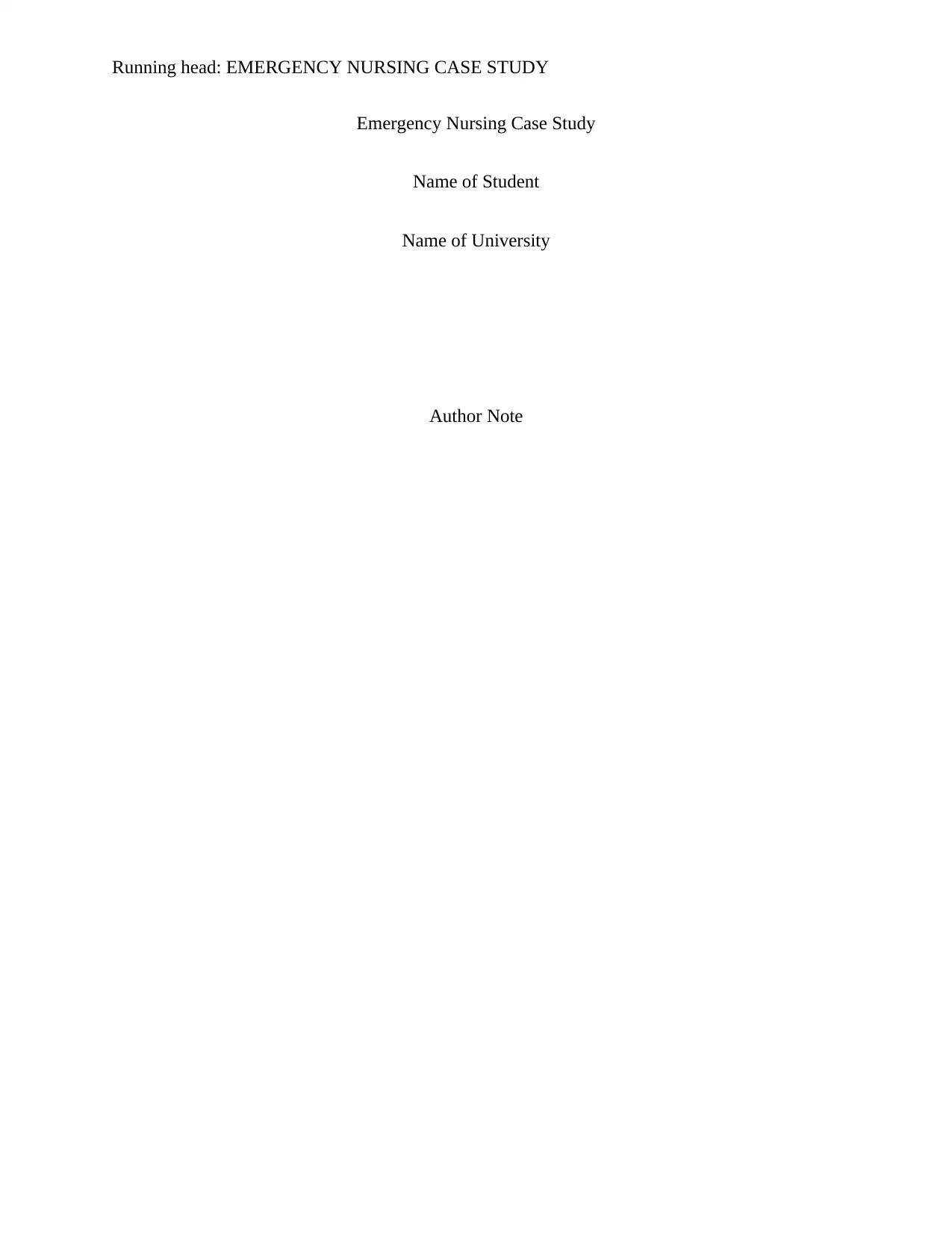
Running head: EMERGENCY NURSING CASE STUDY
Emergency Nursing Case Study
Name of Student
Name of University
Author Note
Emergency Nursing Case Study
Name of Student
Name of University
Author Note
Paraphrase This Document
Need a fresh take? Get an instant paraphrase of this document with our AI Paraphraser
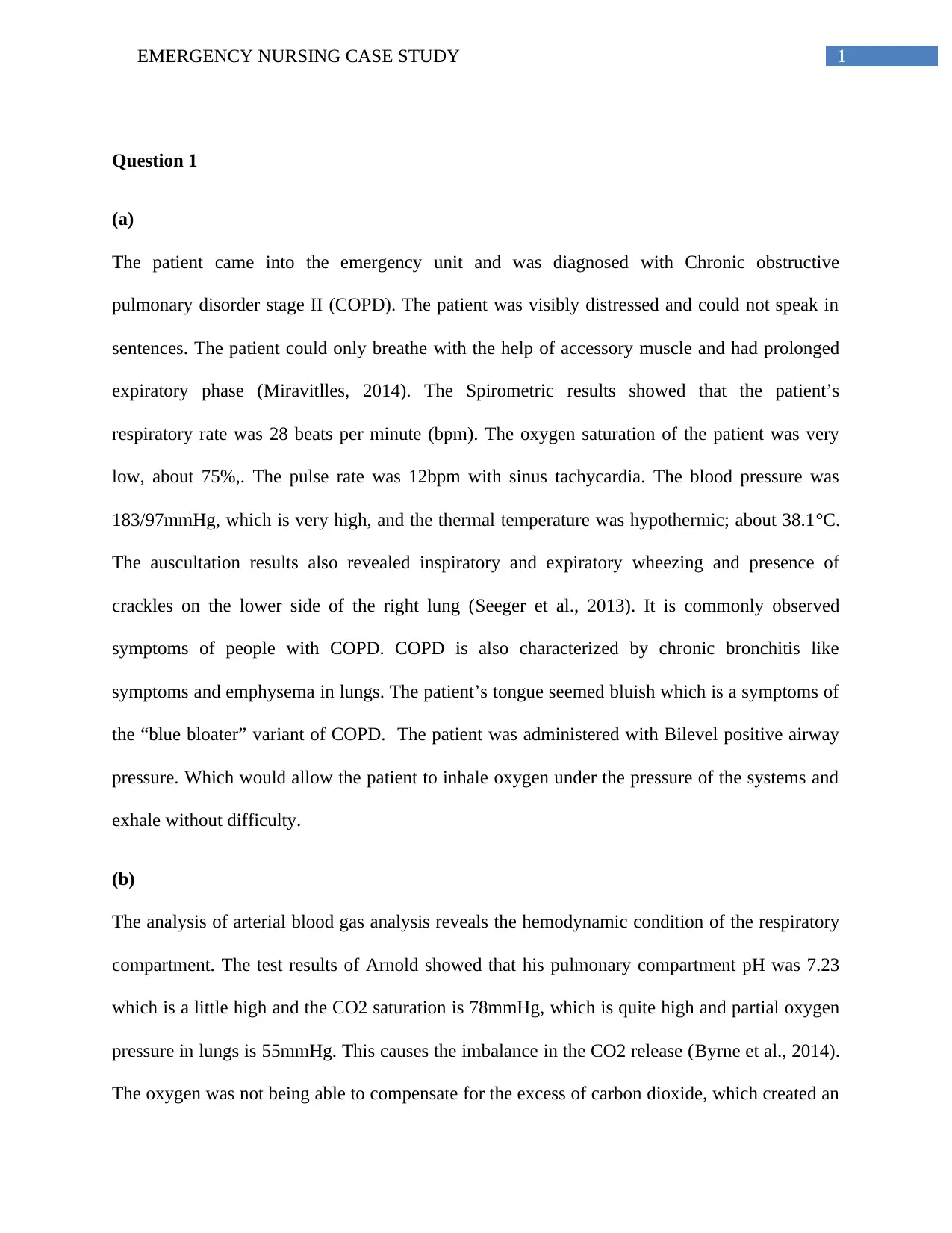
1EMERGENCY NURSING CASE STUDY
Question 1
(a)
The patient came into the emergency unit and was diagnosed with Chronic obstructive
pulmonary disorder stage II (COPD). The patient was visibly distressed and could not speak in
sentences. The patient could only breathe with the help of accessory muscle and had prolonged
expiratory phase (Miravitlles, 2014). The Spirometric results showed that the patient’s
respiratory rate was 28 beats per minute (bpm). The oxygen saturation of the patient was very
low, about 75%,. The pulse rate was 12bpm with sinus tachycardia. The blood pressure was
183/97mmHg, which is very high, and the thermal temperature was hypothermic; about 38.1°C.
The auscultation results also revealed inspiratory and expiratory wheezing and presence of
crackles on the lower side of the right lung (Seeger et al., 2013). It is commonly observed
symptoms of people with COPD. COPD is also characterized by chronic bronchitis like
symptoms and emphysema in lungs. The patient’s tongue seemed bluish which is a symptoms of
the “blue bloater” variant of COPD. The patient was administered with Bilevel positive airway
pressure. Which would allow the patient to inhale oxygen under the pressure of the systems and
exhale without difficulty.
(b)
The analysis of arterial blood gas analysis reveals the hemodynamic condition of the respiratory
compartment. The test results of Arnold showed that his pulmonary compartment pH was 7.23
which is a little high and the CO2 saturation is 78mmHg, which is quite high and partial oxygen
pressure in lungs is 55mmHg. This causes the imbalance in the CO2 release (Byrne et al., 2014).
The oxygen was not being able to compensate for the excess of carbon dioxide, which created an
Question 1
(a)
The patient came into the emergency unit and was diagnosed with Chronic obstructive
pulmonary disorder stage II (COPD). The patient was visibly distressed and could not speak in
sentences. The patient could only breathe with the help of accessory muscle and had prolonged
expiratory phase (Miravitlles, 2014). The Spirometric results showed that the patient’s
respiratory rate was 28 beats per minute (bpm). The oxygen saturation of the patient was very
low, about 75%,. The pulse rate was 12bpm with sinus tachycardia. The blood pressure was
183/97mmHg, which is very high, and the thermal temperature was hypothermic; about 38.1°C.
The auscultation results also revealed inspiratory and expiratory wheezing and presence of
crackles on the lower side of the right lung (Seeger et al., 2013). It is commonly observed
symptoms of people with COPD. COPD is also characterized by chronic bronchitis like
symptoms and emphysema in lungs. The patient’s tongue seemed bluish which is a symptoms of
the “blue bloater” variant of COPD. The patient was administered with Bilevel positive airway
pressure. Which would allow the patient to inhale oxygen under the pressure of the systems and
exhale without difficulty.
(b)
The analysis of arterial blood gas analysis reveals the hemodynamic condition of the respiratory
compartment. The test results of Arnold showed that his pulmonary compartment pH was 7.23
which is a little high and the CO2 saturation is 78mmHg, which is quite high and partial oxygen
pressure in lungs is 55mmHg. This causes the imbalance in the CO2 release (Byrne et al., 2014).
The oxygen was not being able to compensate for the excess of carbon dioxide, which created an
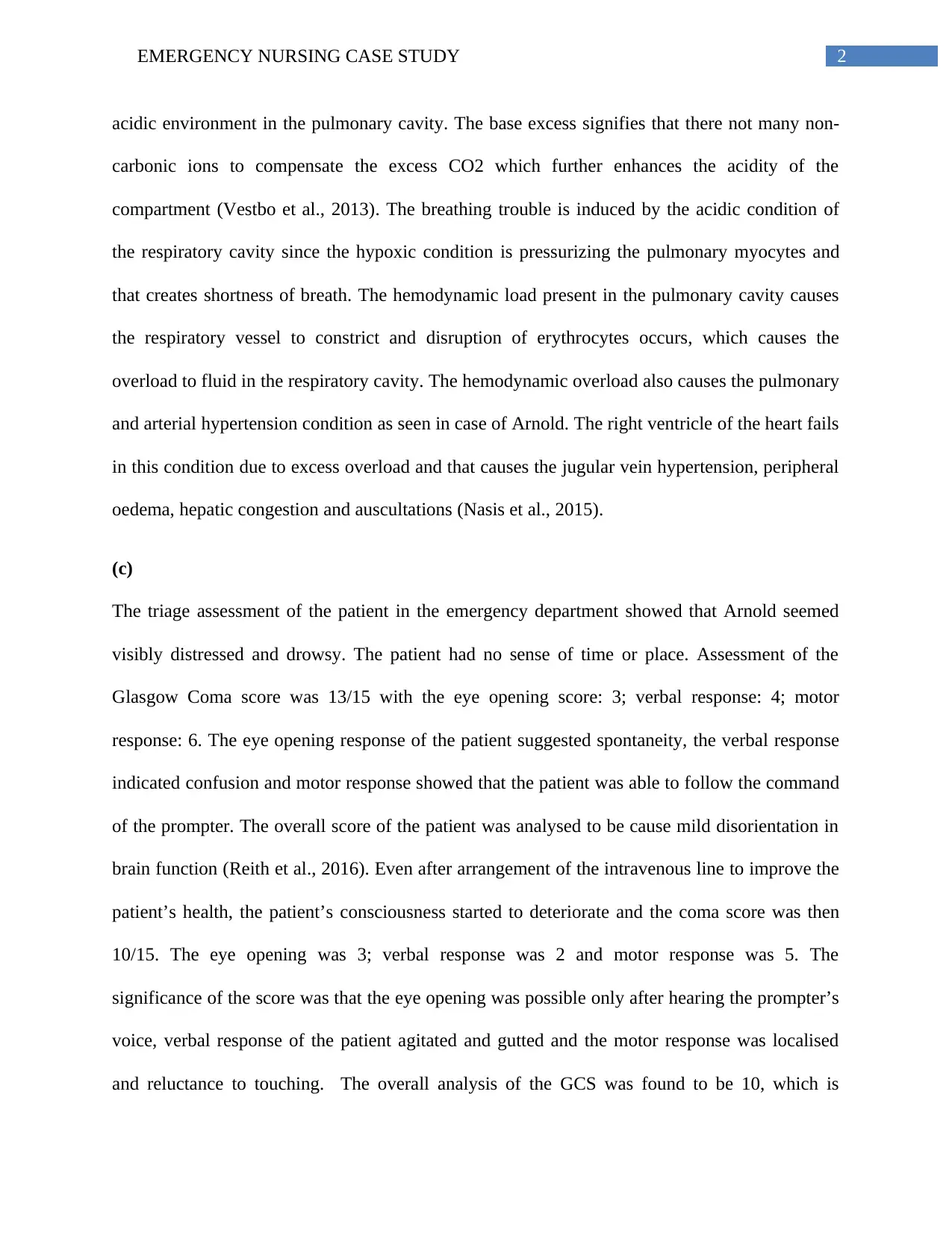
2EMERGENCY NURSING CASE STUDY
acidic environment in the pulmonary cavity. The base excess signifies that there not many non-
carbonic ions to compensate the excess CO2 which further enhances the acidity of the
compartment (Vestbo et al., 2013). The breathing trouble is induced by the acidic condition of
the respiratory cavity since the hypoxic condition is pressurizing the pulmonary myocytes and
that creates shortness of breath. The hemodynamic load present in the pulmonary cavity causes
the respiratory vessel to constrict and disruption of erythrocytes occurs, which causes the
overload to fluid in the respiratory cavity. The hemodynamic overload also causes the pulmonary
and arterial hypertension condition as seen in case of Arnold. The right ventricle of the heart fails
in this condition due to excess overload and that causes the jugular vein hypertension, peripheral
oedema, hepatic congestion and auscultations (Nasis et al., 2015).
(c)
The triage assessment of the patient in the emergency department showed that Arnold seemed
visibly distressed and drowsy. The patient had no sense of time or place. Assessment of the
Glasgow Coma score was 13/15 with the eye opening score: 3; verbal response: 4; motor
response: 6. The eye opening response of the patient suggested spontaneity, the verbal response
indicated confusion and motor response showed that the patient was able to follow the command
of the prompter. The overall score of the patient was analysed to be cause mild disorientation in
brain function (Reith et al., 2016). Even after arrangement of the intravenous line to improve the
patient’s health, the patient’s consciousness started to deteriorate and the coma score was then
10/15. The eye opening was 3; verbal response was 2 and motor response was 5. The
significance of the score was that the eye opening was possible only after hearing the prompter’s
voice, verbal response of the patient agitated and gutted and the motor response was localised
and reluctance to touching. The overall analysis of the GCS was found to be 10, which is
acidic environment in the pulmonary cavity. The base excess signifies that there not many non-
carbonic ions to compensate the excess CO2 which further enhances the acidity of the
compartment (Vestbo et al., 2013). The breathing trouble is induced by the acidic condition of
the respiratory cavity since the hypoxic condition is pressurizing the pulmonary myocytes and
that creates shortness of breath. The hemodynamic load present in the pulmonary cavity causes
the respiratory vessel to constrict and disruption of erythrocytes occurs, which causes the
overload to fluid in the respiratory cavity. The hemodynamic overload also causes the pulmonary
and arterial hypertension condition as seen in case of Arnold. The right ventricle of the heart fails
in this condition due to excess overload and that causes the jugular vein hypertension, peripheral
oedema, hepatic congestion and auscultations (Nasis et al., 2015).
(c)
The triage assessment of the patient in the emergency department showed that Arnold seemed
visibly distressed and drowsy. The patient had no sense of time or place. Assessment of the
Glasgow Coma score was 13/15 with the eye opening score: 3; verbal response: 4; motor
response: 6. The eye opening response of the patient suggested spontaneity, the verbal response
indicated confusion and motor response showed that the patient was able to follow the command
of the prompter. The overall score of the patient was analysed to be cause mild disorientation in
brain function (Reith et al., 2016). Even after arrangement of the intravenous line to improve the
patient’s health, the patient’s consciousness started to deteriorate and the coma score was then
10/15. The eye opening was 3; verbal response was 2 and motor response was 5. The
significance of the score was that the eye opening was possible only after hearing the prompter’s
voice, verbal response of the patient agitated and gutted and the motor response was localised
and reluctance to touching. The overall analysis of the GCS was found to be 10, which is
⊘ This is a preview!⊘
Do you want full access?
Subscribe today to unlock all pages.

Trusted by 1+ million students worldwide
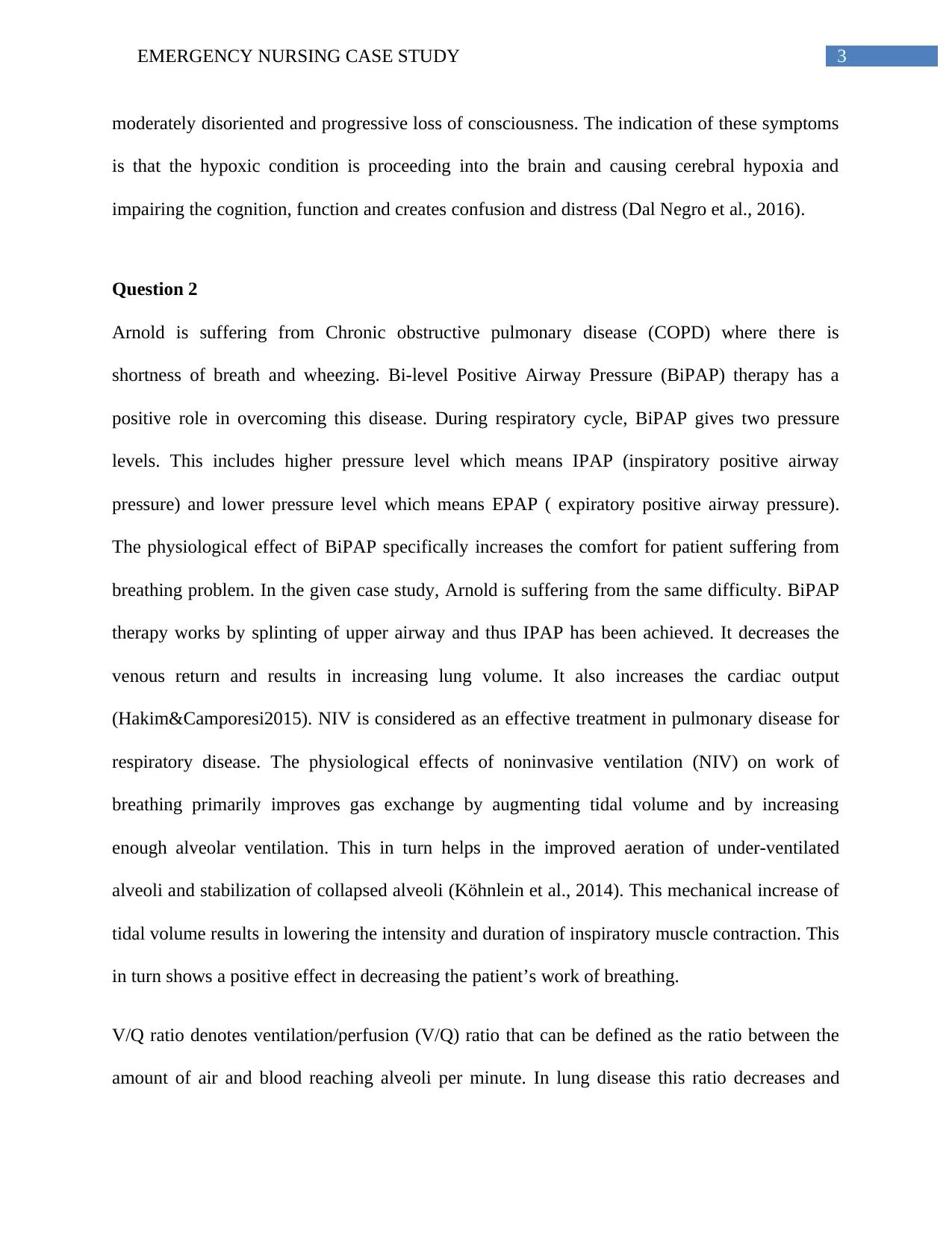
3EMERGENCY NURSING CASE STUDY
moderately disoriented and progressive loss of consciousness. The indication of these symptoms
is that the hypoxic condition is proceeding into the brain and causing cerebral hypoxia and
impairing the cognition, function and creates confusion and distress (Dal Negro et al., 2016).
Question 2
Arnold is suffering from Chronic obstructive pulmonary disease (COPD) where there is
shortness of breath and wheezing. Bi-level Positive Airway Pressure (BiPAP) therapy has a
positive role in overcoming this disease. During respiratory cycle, BiPAP gives two pressure
levels. This includes higher pressure level which means IPAP (inspiratory positive airway
pressure) and lower pressure level which means EPAP ( expiratory positive airway pressure).
The physiological effect of BiPAP specifically increases the comfort for patient suffering from
breathing problem. In the given case study, Arnold is suffering from the same difficulty. BiPAP
therapy works by splinting of upper airway and thus IPAP has been achieved. It decreases the
venous return and results in increasing lung volume. It also increases the cardiac output
(Hakim&Camporesi2015). NIV is considered as an effective treatment in pulmonary disease for
respiratory disease. The physiological effects of noninvasive ventilation (NIV) on work of
breathing primarily improves gas exchange by augmenting tidal volume and by increasing
enough alveolar ventilation. This in turn helps in the improved aeration of under-ventilated
alveoli and stabilization of collapsed alveoli (Köhnlein et al., 2014). This mechanical increase of
tidal volume results in lowering the intensity and duration of inspiratory muscle contraction. This
in turn shows a positive effect in decreasing the patient’s work of breathing.
V/Q ratio denotes ventilation/perfusion (V/Q) ratio that can be defined as the ratio between the
amount of air and blood reaching alveoli per minute. In lung disease this ratio decreases and
moderately disoriented and progressive loss of consciousness. The indication of these symptoms
is that the hypoxic condition is proceeding into the brain and causing cerebral hypoxia and
impairing the cognition, function and creates confusion and distress (Dal Negro et al., 2016).
Question 2
Arnold is suffering from Chronic obstructive pulmonary disease (COPD) where there is
shortness of breath and wheezing. Bi-level Positive Airway Pressure (BiPAP) therapy has a
positive role in overcoming this disease. During respiratory cycle, BiPAP gives two pressure
levels. This includes higher pressure level which means IPAP (inspiratory positive airway
pressure) and lower pressure level which means EPAP ( expiratory positive airway pressure).
The physiological effect of BiPAP specifically increases the comfort for patient suffering from
breathing problem. In the given case study, Arnold is suffering from the same difficulty. BiPAP
therapy works by splinting of upper airway and thus IPAP has been achieved. It decreases the
venous return and results in increasing lung volume. It also increases the cardiac output
(Hakim&Camporesi2015). NIV is considered as an effective treatment in pulmonary disease for
respiratory disease. The physiological effects of noninvasive ventilation (NIV) on work of
breathing primarily improves gas exchange by augmenting tidal volume and by increasing
enough alveolar ventilation. This in turn helps in the improved aeration of under-ventilated
alveoli and stabilization of collapsed alveoli (Köhnlein et al., 2014). This mechanical increase of
tidal volume results in lowering the intensity and duration of inspiratory muscle contraction. This
in turn shows a positive effect in decreasing the patient’s work of breathing.
V/Q ratio denotes ventilation/perfusion (V/Q) ratio that can be defined as the ratio between the
amount of air and blood reaching alveoli per minute. In lung disease this ratio decreases and
Paraphrase This Document
Need a fresh take? Get an instant paraphrase of this document with our AI Paraphraser
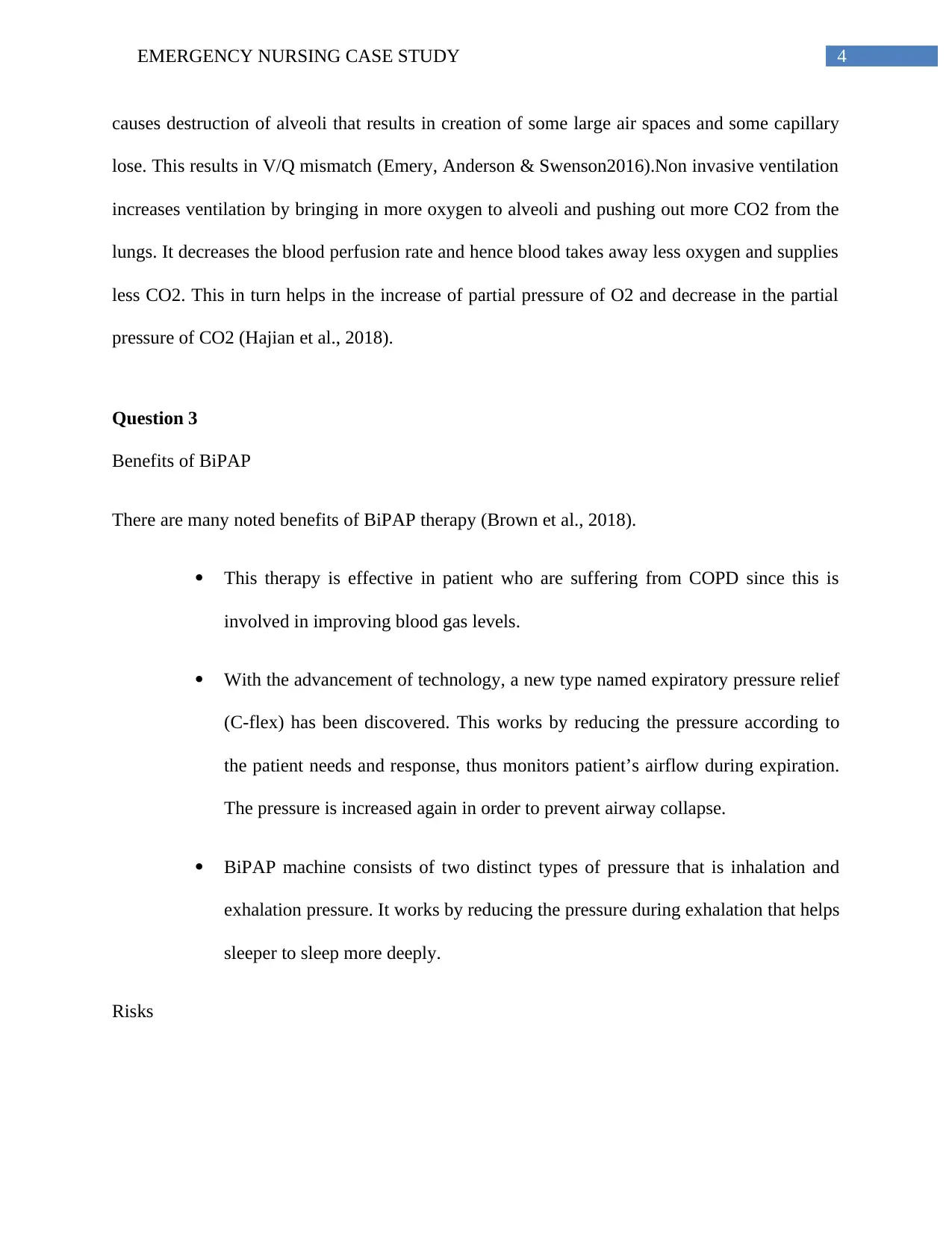
4EMERGENCY NURSING CASE STUDY
causes destruction of alveoli that results in creation of some large air spaces and some capillary
lose. This results in V/Q mismatch (Emery, Anderson & Swenson2016).Non invasive ventilation
increases ventilation by bringing in more oxygen to alveoli and pushing out more CO2 from the
lungs. It decreases the blood perfusion rate and hence blood takes away less oxygen and supplies
less CO2. This in turn helps in the increase of partial pressure of O2 and decrease in the partial
pressure of CO2 (Hajian et al., 2018).
Question 3
Benefits of BiPAP
There are many noted benefits of BiPAP therapy (Brown et al., 2018).
This therapy is effective in patient who are suffering from COPD since this is
involved in improving blood gas levels.
With the advancement of technology, a new type named expiratory pressure relief
(C-flex) has been discovered. This works by reducing the pressure according to
the patient needs and response, thus monitors patient’s airflow during expiration.
The pressure is increased again in order to prevent airway collapse.
BiPAP machine consists of two distinct types of pressure that is inhalation and
exhalation pressure. It works by reducing the pressure during exhalation that helps
sleeper to sleep more deeply.
Risks
causes destruction of alveoli that results in creation of some large air spaces and some capillary
lose. This results in V/Q mismatch (Emery, Anderson & Swenson2016).Non invasive ventilation
increases ventilation by bringing in more oxygen to alveoli and pushing out more CO2 from the
lungs. It decreases the blood perfusion rate and hence blood takes away less oxygen and supplies
less CO2. This in turn helps in the increase of partial pressure of O2 and decrease in the partial
pressure of CO2 (Hajian et al., 2018).
Question 3
Benefits of BiPAP
There are many noted benefits of BiPAP therapy (Brown et al., 2018).
This therapy is effective in patient who are suffering from COPD since this is
involved in improving blood gas levels.
With the advancement of technology, a new type named expiratory pressure relief
(C-flex) has been discovered. This works by reducing the pressure according to
the patient needs and response, thus monitors patient’s airflow during expiration.
The pressure is increased again in order to prevent airway collapse.
BiPAP machine consists of two distinct types of pressure that is inhalation and
exhalation pressure. It works by reducing the pressure during exhalation that helps
sleeper to sleep more deeply.
Risks
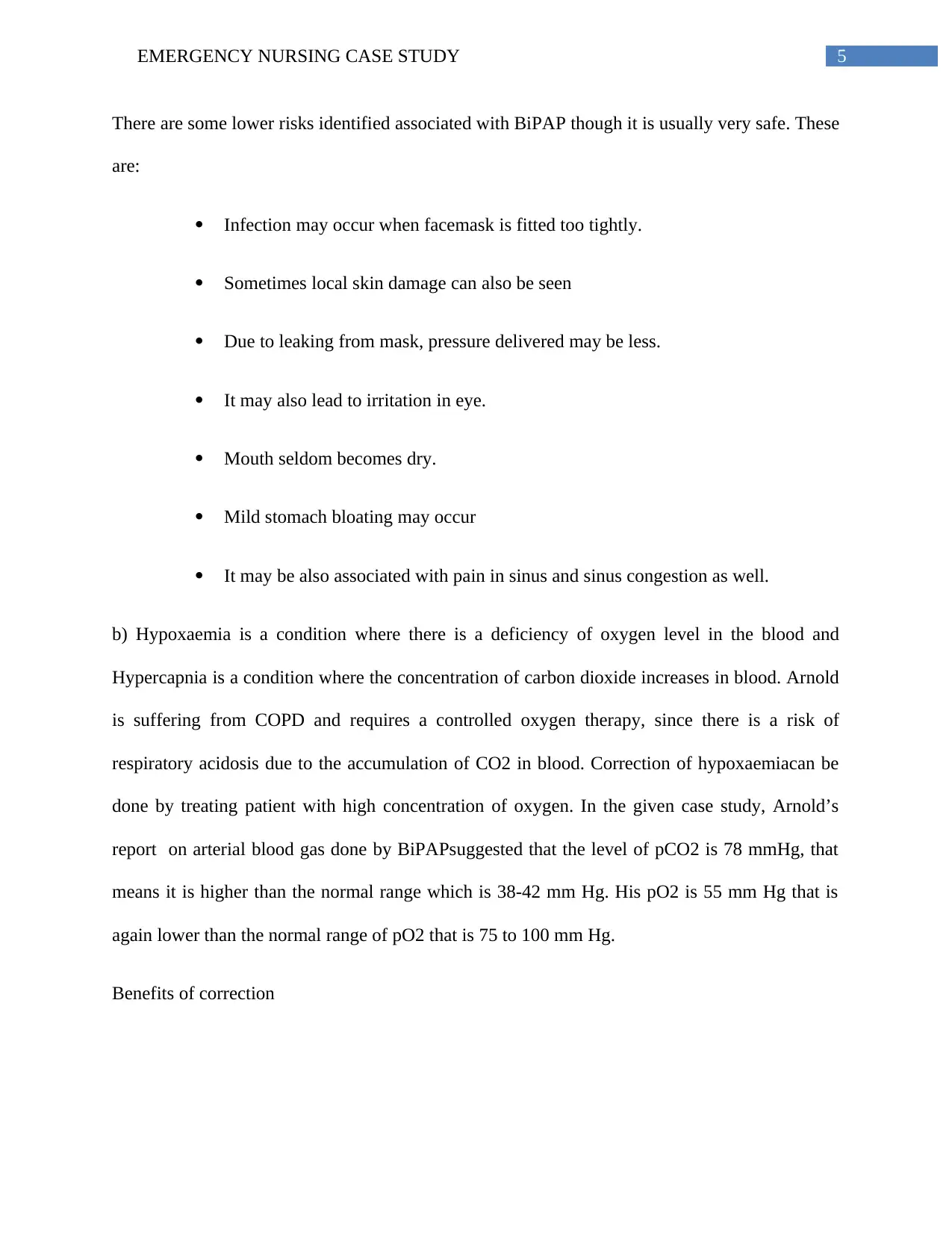
5EMERGENCY NURSING CASE STUDY
There are some lower risks identified associated with BiPAP though it is usually very safe. These
are:
Infection may occur when facemask is fitted too tightly.
Sometimes local skin damage can also be seen
Due to leaking from mask, pressure delivered may be less.
It may also lead to irritation in eye.
Mouth seldom becomes dry.
Mild stomach bloating may occur
It may be also associated with pain in sinus and sinus congestion as well.
b) Hypoxaemia is a condition where there is a deficiency of oxygen level in the blood and
Hypercapnia is a condition where the concentration of carbon dioxide increases in blood. Arnold
is suffering from COPD and requires a controlled oxygen therapy, since there is a risk of
respiratory acidosis due to the accumulation of CO2 in blood. Correction of hypoxaemiacan be
done by treating patient with high concentration of oxygen. In the given case study, Arnold’s
report on arterial blood gas done by BiPAPsuggested that the level of pCO2 is 78 mmHg, that
means it is higher than the normal range which is 38-42 mm Hg. His pO2 is 55 mm Hg that is
again lower than the normal range of pO2 that is 75 to 100 mm Hg.
Benefits of correction
There are some lower risks identified associated with BiPAP though it is usually very safe. These
are:
Infection may occur when facemask is fitted too tightly.
Sometimes local skin damage can also be seen
Due to leaking from mask, pressure delivered may be less.
It may also lead to irritation in eye.
Mouth seldom becomes dry.
Mild stomach bloating may occur
It may be also associated with pain in sinus and sinus congestion as well.
b) Hypoxaemia is a condition where there is a deficiency of oxygen level in the blood and
Hypercapnia is a condition where the concentration of carbon dioxide increases in blood. Arnold
is suffering from COPD and requires a controlled oxygen therapy, since there is a risk of
respiratory acidosis due to the accumulation of CO2 in blood. Correction of hypoxaemiacan be
done by treating patient with high concentration of oxygen. In the given case study, Arnold’s
report on arterial blood gas done by BiPAPsuggested that the level of pCO2 is 78 mmHg, that
means it is higher than the normal range which is 38-42 mm Hg. His pO2 is 55 mm Hg that is
again lower than the normal range of pO2 that is 75 to 100 mm Hg.
Benefits of correction
⊘ This is a preview!⊘
Do you want full access?
Subscribe today to unlock all pages.

Trusted by 1+ million students worldwide
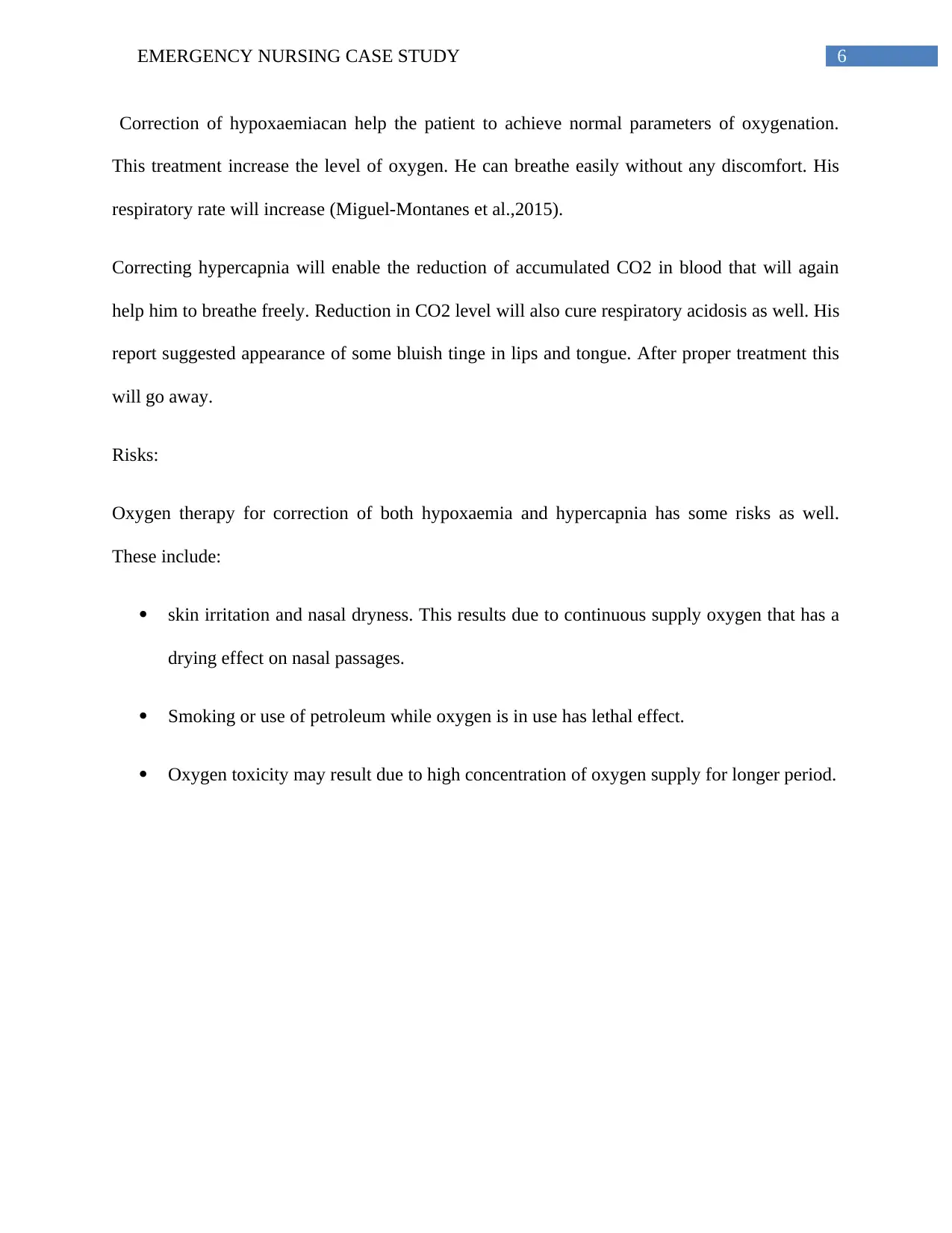
6EMERGENCY NURSING CASE STUDY
Correction of hypoxaemiacan help the patient to achieve normal parameters of oxygenation.
This treatment increase the level of oxygen. He can breathe easily without any discomfort. His
respiratory rate will increase (Miguel-Montanes et al.,2015).
Correcting hypercapnia will enable the reduction of accumulated CO2 in blood that will again
help him to breathe freely. Reduction in CO2 level will also cure respiratory acidosis as well. His
report suggested appearance of some bluish tinge in lips and tongue. After proper treatment this
will go away.
Risks:
Oxygen therapy for correction of both hypoxaemia and hypercapnia has some risks as well.
These include:
skin irritation and nasal dryness. This results due to continuous supply oxygen that has a
drying effect on nasal passages.
Smoking or use of petroleum while oxygen is in use has lethal effect.
Oxygen toxicity may result due to high concentration of oxygen supply for longer period.
Correction of hypoxaemiacan help the patient to achieve normal parameters of oxygenation.
This treatment increase the level of oxygen. He can breathe easily without any discomfort. His
respiratory rate will increase (Miguel-Montanes et al.,2015).
Correcting hypercapnia will enable the reduction of accumulated CO2 in blood that will again
help him to breathe freely. Reduction in CO2 level will also cure respiratory acidosis as well. His
report suggested appearance of some bluish tinge in lips and tongue. After proper treatment this
will go away.
Risks:
Oxygen therapy for correction of both hypoxaemia and hypercapnia has some risks as well.
These include:
skin irritation and nasal dryness. This results due to continuous supply oxygen that has a
drying effect on nasal passages.
Smoking or use of petroleum while oxygen is in use has lethal effect.
Oxygen toxicity may result due to high concentration of oxygen supply for longer period.
Paraphrase This Document
Need a fresh take? Get an instant paraphrase of this document with our AI Paraphraser
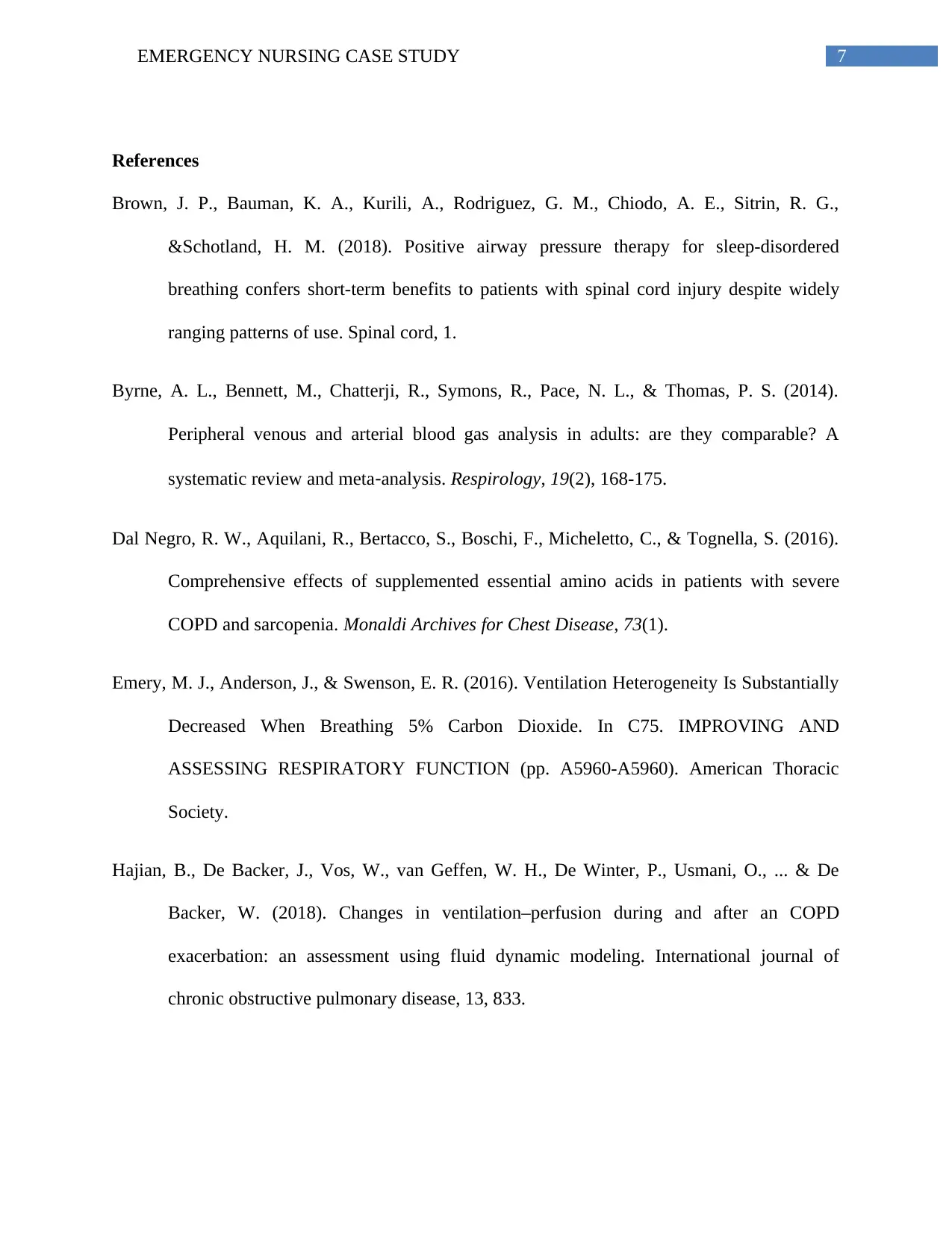
7EMERGENCY NURSING CASE STUDY
References
Brown, J. P., Bauman, K. A., Kurili, A., Rodriguez, G. M., Chiodo, A. E., Sitrin, R. G.,
&Schotland, H. M. (2018). Positive airway pressure therapy for sleep-disordered
breathing confers short-term benefits to patients with spinal cord injury despite widely
ranging patterns of use. Spinal cord, 1.
Byrne, A. L., Bennett, M., Chatterji, R., Symons, R., Pace, N. L., & Thomas, P. S. (2014).
Peripheral venous and arterial blood gas analysis in adults: are they comparable? A
systematic review and meta‐analysis. Respirology, 19(2), 168-175.
Dal Negro, R. W., Aquilani, R., Bertacco, S., Boschi, F., Micheletto, C., & Tognella, S. (2016).
Comprehensive effects of supplemented essential amino acids in patients with severe
COPD and sarcopenia. Monaldi Archives for Chest Disease, 73(1).
Emery, M. J., Anderson, J., & Swenson, E. R. (2016). Ventilation Heterogeneity Is Substantially
Decreased When Breathing 5% Carbon Dioxide. In C75. IMPROVING AND
ASSESSING RESPIRATORY FUNCTION (pp. A5960-A5960). American Thoracic
Society.
Hajian, B., De Backer, J., Vos, W., van Geffen, W. H., De Winter, P., Usmani, O., ... & De
Backer, W. (2018). Changes in ventilation–perfusion during and after an COPD
exacerbation: an assessment using fluid dynamic modeling. International journal of
chronic obstructive pulmonary disease, 13, 833.
References
Brown, J. P., Bauman, K. A., Kurili, A., Rodriguez, G. M., Chiodo, A. E., Sitrin, R. G.,
&Schotland, H. M. (2018). Positive airway pressure therapy for sleep-disordered
breathing confers short-term benefits to patients with spinal cord injury despite widely
ranging patterns of use. Spinal cord, 1.
Byrne, A. L., Bennett, M., Chatterji, R., Symons, R., Pace, N. L., & Thomas, P. S. (2014).
Peripheral venous and arterial blood gas analysis in adults: are they comparable? A
systematic review and meta‐analysis. Respirology, 19(2), 168-175.
Dal Negro, R. W., Aquilani, R., Bertacco, S., Boschi, F., Micheletto, C., & Tognella, S. (2016).
Comprehensive effects of supplemented essential amino acids in patients with severe
COPD and sarcopenia. Monaldi Archives for Chest Disease, 73(1).
Emery, M. J., Anderson, J., & Swenson, E. R. (2016). Ventilation Heterogeneity Is Substantially
Decreased When Breathing 5% Carbon Dioxide. In C75. IMPROVING AND
ASSESSING RESPIRATORY FUNCTION (pp. A5960-A5960). American Thoracic
Society.
Hajian, B., De Backer, J., Vos, W., van Geffen, W. H., De Winter, P., Usmani, O., ... & De
Backer, W. (2018). Changes in ventilation–perfusion during and after an COPD
exacerbation: an assessment using fluid dynamic modeling. International journal of
chronic obstructive pulmonary disease, 13, 833.
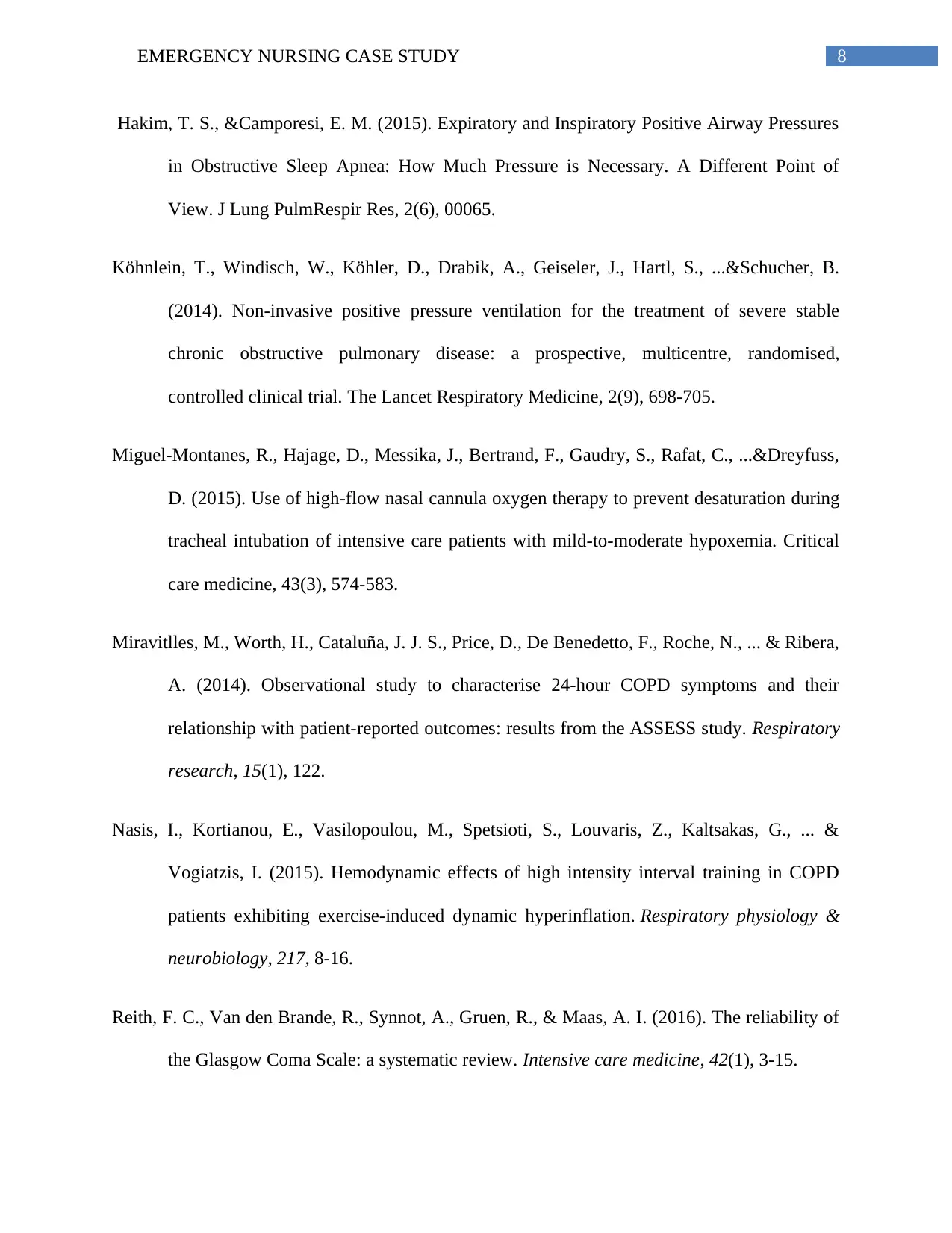
8EMERGENCY NURSING CASE STUDY
Hakim, T. S., &Camporesi, E. M. (2015). Expiratory and Inspiratory Positive Airway Pressures
in Obstructive Sleep Apnea: How Much Pressure is Necessary. A Different Point of
View. J Lung PulmRespir Res, 2(6), 00065.
Köhnlein, T., Windisch, W., Köhler, D., Drabik, A., Geiseler, J., Hartl, S., ...&Schucher, B.
(2014). Non-invasive positive pressure ventilation for the treatment of severe stable
chronic obstructive pulmonary disease: a prospective, multicentre, randomised,
controlled clinical trial. The Lancet Respiratory Medicine, 2(9), 698-705.
Miguel-Montanes, R., Hajage, D., Messika, J., Bertrand, F., Gaudry, S., Rafat, C., ...&Dreyfuss,
D. (2015). Use of high-flow nasal cannula oxygen therapy to prevent desaturation during
tracheal intubation of intensive care patients with mild-to-moderate hypoxemia. Critical
care medicine, 43(3), 574-583.
Miravitlles, M., Worth, H., Cataluña, J. J. S., Price, D., De Benedetto, F., Roche, N., ... & Ribera,
A. (2014). Observational study to characterise 24-hour COPD symptoms and their
relationship with patient-reported outcomes: results from the ASSESS study. Respiratory
research, 15(1), 122.
Nasis, I., Kortianou, E., Vasilopoulou, Μ., Spetsioti, S., Louvaris, Z., Kaltsakas, G., ... &
Vogiatzis, I. (2015). Hemodynamic effects of high intensity interval training in COPD
patients exhibiting exercise-induced dynamic hyperinflation. Respiratory physiology &
neurobiology, 217, 8-16.
Reith, F. C., Van den Brande, R., Synnot, A., Gruen, R., & Maas, A. I. (2016). The reliability of
the Glasgow Coma Scale: a systematic review. Intensive care medicine, 42(1), 3-15.
Hakim, T. S., &Camporesi, E. M. (2015). Expiratory and Inspiratory Positive Airway Pressures
in Obstructive Sleep Apnea: How Much Pressure is Necessary. A Different Point of
View. J Lung PulmRespir Res, 2(6), 00065.
Köhnlein, T., Windisch, W., Köhler, D., Drabik, A., Geiseler, J., Hartl, S., ...&Schucher, B.
(2014). Non-invasive positive pressure ventilation for the treatment of severe stable
chronic obstructive pulmonary disease: a prospective, multicentre, randomised,
controlled clinical trial. The Lancet Respiratory Medicine, 2(9), 698-705.
Miguel-Montanes, R., Hajage, D., Messika, J., Bertrand, F., Gaudry, S., Rafat, C., ...&Dreyfuss,
D. (2015). Use of high-flow nasal cannula oxygen therapy to prevent desaturation during
tracheal intubation of intensive care patients with mild-to-moderate hypoxemia. Critical
care medicine, 43(3), 574-583.
Miravitlles, M., Worth, H., Cataluña, J. J. S., Price, D., De Benedetto, F., Roche, N., ... & Ribera,
A. (2014). Observational study to characterise 24-hour COPD symptoms and their
relationship with patient-reported outcomes: results from the ASSESS study. Respiratory
research, 15(1), 122.
Nasis, I., Kortianou, E., Vasilopoulou, Μ., Spetsioti, S., Louvaris, Z., Kaltsakas, G., ... &
Vogiatzis, I. (2015). Hemodynamic effects of high intensity interval training in COPD
patients exhibiting exercise-induced dynamic hyperinflation. Respiratory physiology &
neurobiology, 217, 8-16.
Reith, F. C., Van den Brande, R., Synnot, A., Gruen, R., & Maas, A. I. (2016). The reliability of
the Glasgow Coma Scale: a systematic review. Intensive care medicine, 42(1), 3-15.
⊘ This is a preview!⊘
Do you want full access?
Subscribe today to unlock all pages.

Trusted by 1+ million students worldwide
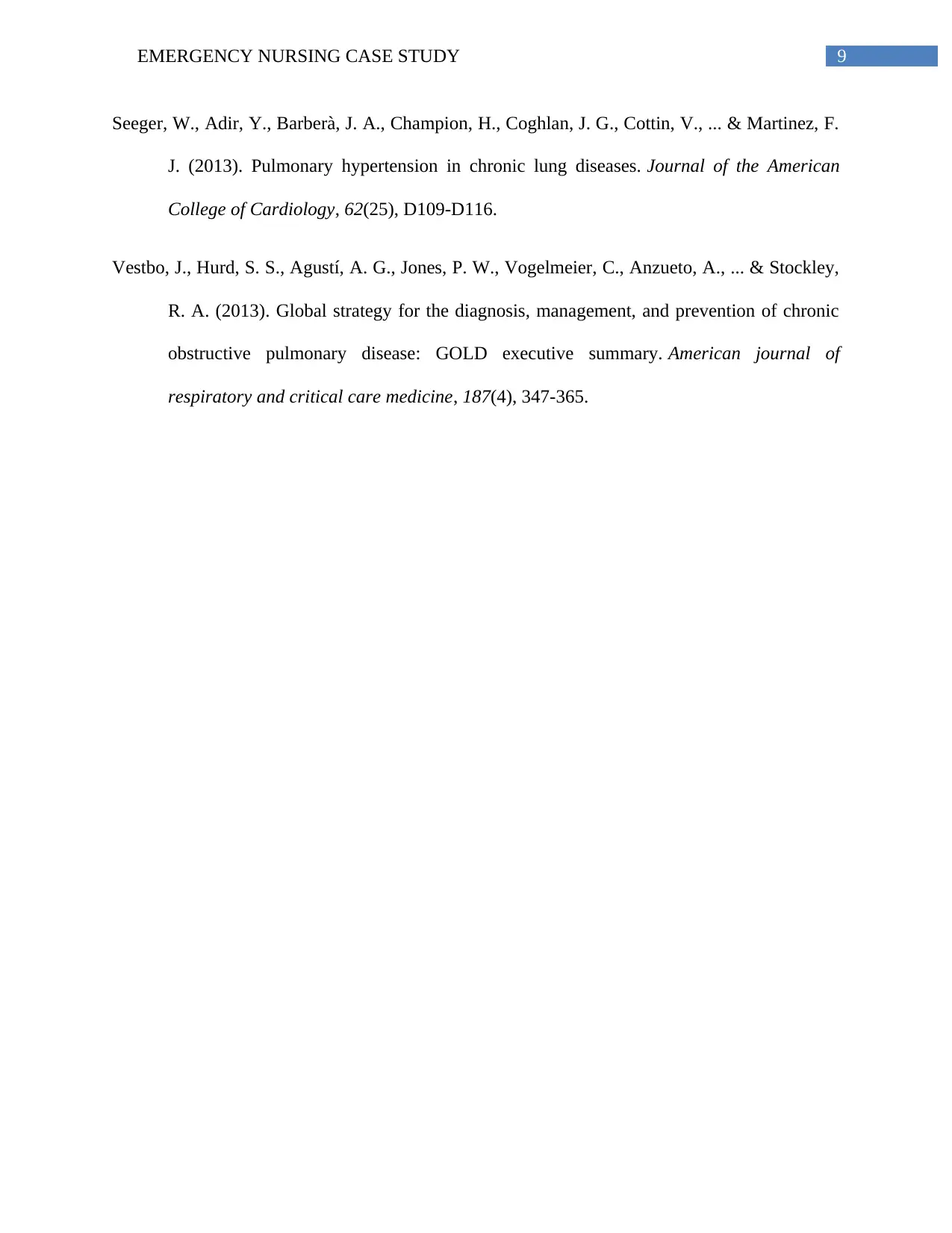
9EMERGENCY NURSING CASE STUDY
Seeger, W., Adir, Y., Barberà, J. A., Champion, H., Coghlan, J. G., Cottin, V., ... & Martinez, F.
J. (2013). Pulmonary hypertension in chronic lung diseases. Journal of the American
College of Cardiology, 62(25), D109-D116.
Vestbo, J., Hurd, S. S., Agustí, A. G., Jones, P. W., Vogelmeier, C., Anzueto, A., ... & Stockley,
R. A. (2013). Global strategy for the diagnosis, management, and prevention of chronic
obstructive pulmonary disease: GOLD executive summary. American journal of
respiratory and critical care medicine, 187(4), 347-365.
Seeger, W., Adir, Y., Barberà, J. A., Champion, H., Coghlan, J. G., Cottin, V., ... & Martinez, F.
J. (2013). Pulmonary hypertension in chronic lung diseases. Journal of the American
College of Cardiology, 62(25), D109-D116.
Vestbo, J., Hurd, S. S., Agustí, A. G., Jones, P. W., Vogelmeier, C., Anzueto, A., ... & Stockley,
R. A. (2013). Global strategy for the diagnosis, management, and prevention of chronic
obstructive pulmonary disease: GOLD executive summary. American journal of
respiratory and critical care medicine, 187(4), 347-365.
1 out of 10
Related Documents
Your All-in-One AI-Powered Toolkit for Academic Success.
+13062052269
info@desklib.com
Available 24*7 on WhatsApp / Email
![[object Object]](/_next/static/media/star-bottom.7253800d.svg)
Unlock your academic potential
Copyright © 2020–2025 A2Z Services. All Rights Reserved. Developed and managed by ZUCOL.




